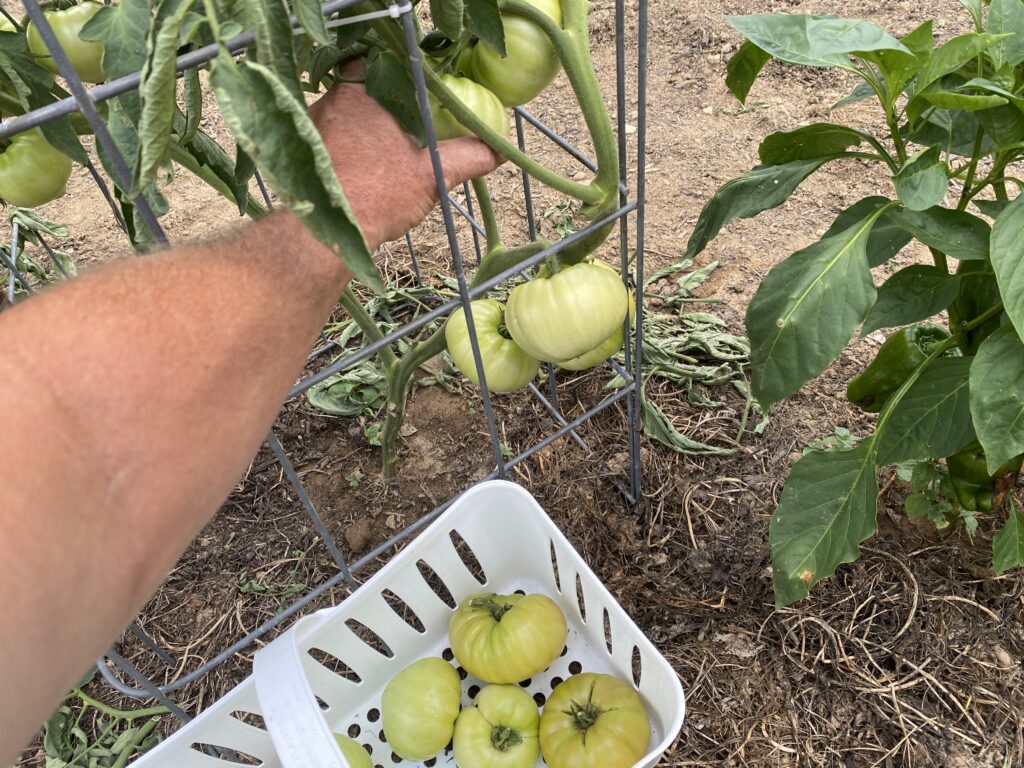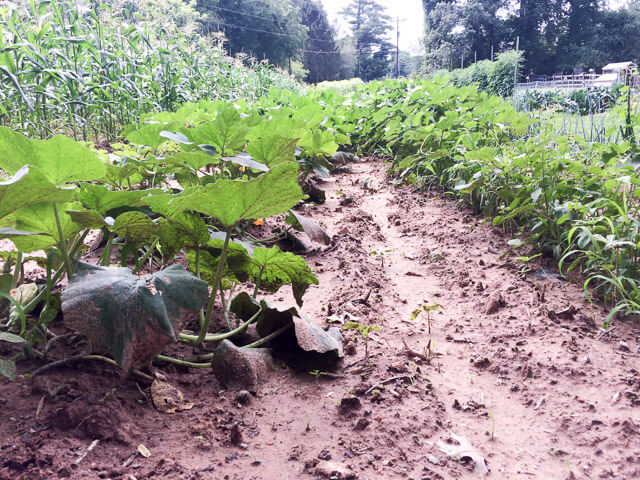Gardening Tasks To Do in July

Sweet summertime!
The garden is flourishing, kids are barefoot, and fireflies light up the evenings.
Here’s a list of garden tasks we try to tackle in July. If you’re feeling overwhelmed by the garden’s bounty, you’ll find some tips for keeping it simple here, too.
Who Is This For?
Our garden checklist is for gardeners interested in growing food and healthy ecosystems. We use organic methods, get the whole family involved, and look for ways to mimic nature using permaculture ideas.
We live in the Northern Hemisphere in USDA Zone 7. These recommendations can be applied to many gardens in Zone 6-8. (Not sure what your zone is? Find your USDA zone here. Not in the U.S.? These plant maps may help.
Quick 3 for Busy Gardeners
If you have limited time for gardening (and reading!), I recommend you focus on these three areas this month:
- Visit your garden every day. You’ll be able to harvest, weed, or just observe while there. If you planted extra (like I always do!), this is the time of year when the garden can get overwhelming. I like the “10 Minute Rule” from garden author Sharon Lovejoy—every day, you spend at least 10 minutes exploring the garden!
- Water deeply and consistently. If you aren’t getting consistent rain, most veggies will need supplemental watering. Think deep…then dry. You want to get the water down into the root zone, then allow the soil to dry some before watering again. Also, water at ground level with a wand or drip irrigation to avoid getting the plant wet. Moisture on the leaves/fruits = perfect conditions for fungal disease.
- Learn about and manage pests. As you’re in the garden, get to know the pests eating the food you’d rather eat yourself. Japanese beetles and tomato hornworms are two we often find in our mid-summer garden. You can keep many pests in check by hand-picking them.
July Garden Checklist
Plants

Enjoy the fruits of your labor—daily!
If a garden visit isn’t part of your daily routine, add it this month. Avoid overwhelm with a quick visit each morning or evening to harvest and pull a few weeds while you’re there. Bonus: You won’t let veggies pass their prime…you know, like that whopper of a zucchini you need a harpoon to handle. If you’re freezing or canning this season, take note of things like green beans coming in or a bunch of tomatoes ripening, so that you can plan a time to tackle the bigger projects.Over the last few weeks, we’ve been enjoying fresh broccoli, potatoes, Swiss chard, beets, carrots, zucchini, blueberries and raspberries.
Harvest garlic and onions.
We’re harvesting garlic and onions here. If you haven’t pulled yours yet, it’s probably time! Find more about garlic in last month’s checklist. With onions, watch for floppy, yellow tops. If you have a few perky ones left, bend them over. Give them a week or two more to mature. When the weather is dry for a few days, use a digging fork and pull them. Let them dry in the sun for a day, then spread them on screens in a dry place to finish curing. (Read more about onion harvest and storage.)

Replant as you harvest.
After harvesting your spring and summer vegetables, don’t leave a bare spot. You can use that space to plant some cool-season crops for a fall harvest. Plant beets, broccoli, brussels sprouts, cabbage, carrots, cauliflower, kohlrabi, and chard from seed. Or you can plant a nitrogen-fixing cover crop like clover or vetch to add valuable organic matter and nutrients. Here’s a table to help you plan when to plant based on your last frost date (pdf).
Be amazed by cucumbers.
Watch this video about how plants move, and you’ll look at your cucumbers in a whole new light!
Mind your houseplants.
Many houseplants love to spend the summer in a shady spot outside, but they need to be watered regularly. Watering can wash nutrients out, so feed them once a month with a diluted organic liquid fertilizer or compost tea to keep them healthy and happy.
Water deeply and consistently.
If you need to give your plants supplemental irrigation, the main thing to remember about summer watering is deep, then dry. Water deeply to encourage plants’ roots to grow deeper, where they are less likely to dry out, and allow the soil to dry between waterings. (Shallow watering can be wasteful, since the water doesn’t reach the root zone and evaporates rapidly.) Moisture makes leaves susceptible to disease, so use drip irrigation or water when they’ll have time to dry out during the day.
Mulch.
Mulching has so many benefits! It slows evaporation to conserve water, cools soil, keeps mud off your plants, and suppresses weeds. We use straw, shredded leaves, and grass clippings (no seeds!) for vegetables and berries. Wood chips and pine needles are good for paths, trees, herbs, and shrubs.
Feed your veggies.
If your garden needs an extra boost of nutrients, you can sidedress plants with compost, worm castings, or an organic fertilizer. Tomatoes and peppers may need extra calcium as the fruit begins forming to avoid blossom end rot.
Pick a bouquet.
Home-grown flowers are the perfect complement to the home-grown meal on your dinner table!

Soil
Weed, weed, weed.
Chop and drop your weeds (without seeds) for easy mulch to discourage future weeds. If you’re feeling overwhelmed, focus on the “worst” weeds first. In our case, this includes the pokey ones (cockleburrs, brambles), itchy ones (poison ivy) and aggressive ones (morning glories, grasses).
Build a new compost bin.
Are you composting? It’s always a good time to start! Learn how in our Quick Start to Composting.
Plant some color.
To have some late summer/early fall color in your garden, try planting begonias, marigolds, impatiens, celosia, salvia, asters, verbena, and zinnias. Some of our favorite perennial flowers to give colorful fall food for pollinators are bee balm, goldenrod, and perennial sunflowers like “Lemon Queen”.
Add harvest scraps to your compost.
Gather up the trimmings, scraps, and veggies that didn’t make the cut and turn them into compost for next season’s garden.
Mulch.
Yes, mulch deserves a second mention. In hot, moist weather, mulch can decompose rapidly, so it is a good idea to check your mulched areas. If you think, “Is that enough mulch?”, go ahead and add a layer.
Call a tree company.
While we’re on mulch, let’s talk about having plenty of it on hand. Reach out to local tree companies, utility tree trimmers, and nearby municipalities to find out how they dispose of wood chips. If you have room, you could offer to be a drop-off site, or you may find a free place to pick-up.

Stay out if it’s too wet.
If you’re blessed with rains in summer, you might be blessed with too much rain. What’s a gardener to do? Stay out of the mud! (Unless it’s mud puddle away from the garden and you’re playing.) If you must walk in the garden, use a board to spread out your weight and lessen soil compaction. When you are able to get into the garden, you can weed and even thin your plants to keep air circulating. For the future, you can plan to deal with drainage issues.

Gear
Care for your tools.
Make it a habit to put away your tools every time. Keep them clean(ish) and dry, and they’ll last longer and work better.
Check your watering gear.
Are your hoses and irrigation systems leak-free and working properly? Save time, money, and water by checking them. Easy to lose and easy to replace, washers are one key to leak-free hoses, sprinklers, and sprayers.
Put away hoses when not in use.
Keep hoses rolled up and stored out the sun’s damaging UV rays to add years to their life. You can also protect your semi-permanent drip tubing and soaker hoses by running them under mulch.
Write in your garden journal.
There is so much to do in the garden this month, and it’s easy to forget about taking notes. Keep your journal where you’ll see it and remember to jot down important notes. How else will you remember the day you picked the first ripe red tomato? Or that you should plant the broccoli further apart next year. (Our 18″ spacing was too close!) When you are plotting and planning your next garden, you will be so happy that you recorded your efforts this season. You’ll be able to make improvements, avoid mishaps, relish in triumphs, and save time in thinking about what you did last time.
Snap some pictures.
Getting behind the lens is a great way to slow down and see what’s happening in your garden. Since cameras (and phones) save images with a time stamp, your photo collection can be another way to keep records.
Wildlife
Patrol for tomato hornworms.
Hornworms can destroy your tomato crop in record time if not controlled. (Or peppers…or eggplants…or potatoes!) Caterpillars are eating machines! Missing or wilted leaves and dark droppings are the signs you’ll probably see before you find the well-camouflaged hornworm. Hand-picking is the best control method, although spraying Bt (Bacillus thuringiensis) may be effective. Read more about hornworms and tomato growing tips.

Control Japanese beetles.
It is the peak time for Japanese beetles. If you notice the tell-tale skeletonized leaves on grapes, berries, roses, corn, or other plants, you can control them in a few ways. Hand pick in the morning when they’re moving slow. Repel them with Neem oil or mint-based sprays. Kill them with insecticidal soap. Trap them in pheromone traps (but be aware that these traps can attract all the neighborhood beetles to your yard!) For long-term control, look into parasitic nematodes and/or milky spore to kill the beetle grubs in your lawn.

Plant a cover crop for pollinators.
We love fast-growing buckwheat for summer planting, and bees do, too. Clover is another one that’s good for soil and good for pollinators. Did you know that the flowers honeybees frequent affect the taste of honey? Check out this neat Honey Varietal Guide to learn more and find pollinator planting ideas.
Beyond
Make an easy berry dessert.
1 cup heavy cream + 1 tsp vanilla + a little sweetener (honey, sugar, maple syrup, etc.) – whip it up and add berries for a simple and delicious dessert!

Host a BBQ.
Fresh grilled zucchini, onions, and tomatoes are an awesome addition to a summer barbecue menu. As an added bonus, you don’t heat up the kitchen while you cook! Invite friends or neighbors and enjoy the long summer evening.
Kids
Design a space near the garden that’s especially for the kids.
Get the family involved in creating a fun space where kids can play while you garden. You add a stick teepee, a sandbox, a water table, a wading pool, a big bucket of rocks and sticks (aka natural building blocks!), a log for balancing, or just a big cardboard box.
Work AND play.
When you do want kids to help you in the garden, consider adding a reward for a job well done. Of course, this doesn’t need to happen every time. Sometimes, the beans HAVE to be picked! And other times, the reward is simply the feeling of accomplishment. But I do love a nice bowl of ice cream or a splash in the creek after a hard day’s work, and so do our kids! 🙂

Now, I’d love to hear from you!
What garden tasks are at the top of your list this month?
What projects are you excited about? What chores are you dreading? Let me know in the comments below.


I wish people were not constantly being told to kill all of the tomato hornworms! They turn into the beautiful Hawk moth. Just plant a few extra tomato plants and they will be fine. I have never lost a crop from the few caterpillars I leave alone.